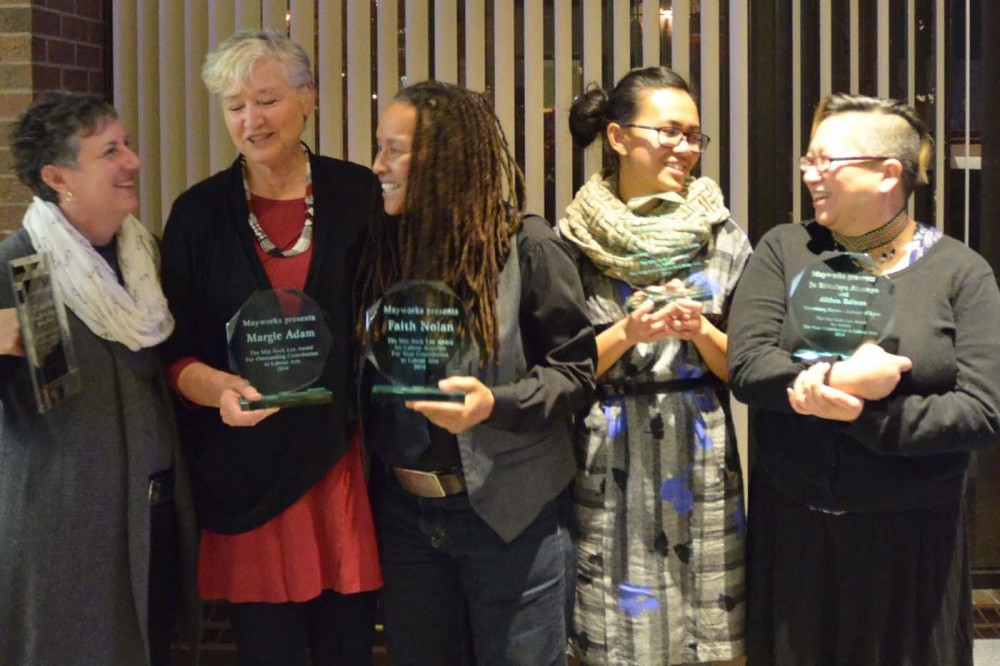People don't understand," says musician, singer/songwriter and community activist Faith Nolan. "They think labour is two old white guys hammering a nail who want more money and to work less. They don't see that those two old white guys, along with white women and brown and black and yellow women and men, are doing this labour to have the right to a life. People have a disconnect in this sense."
Born in Halifax, Nolan grew up in Regent Park, a social housing project in downtown Toronto. She has toured all over Canada, the United States, and Europe. She has helped form social justice choirs and recorded albums with, among others, members of the Canadian Union of Public Employees (CUPE), the Service Employees International Union (SEIU) and the Elementary Teachers of Toronto (ETT).
This past year she was also one of six women recognized for their outstanding contributions to the arts and the labour movement. The ceremony took place on November 29 at the third annual Min Sook Lee Labour Arts Awards gala, hosted by the Mayworks Festival of Working People and the Arts. I had the pleasure of speaking to all five award winners about their work as artists, and about labour and the arts, in particular.
Packed with the award winners' friends and families, as well as members of the Toronto labour arts community, the Steelworkers Hall on Cecil Street had a warm and familial atmosphere. Dinner was provided by the East African Community Association and the evening's agenda was punctuated by music from The Special Interest Group.
FAITH NOLAN
"Mayworks offers a platform for progressives to talk about issues of social justice, and to disseminate them in an emotional way," says Nolan, herself a very warm individual. "Union music," she continues, "is about the right of us, as working people, to have decent housing, jobs, food and working conditions; and dignity and respect for the work that we do."
For the past 30 years, Nolan has worked with women in Ontario jails, including the Vanier Centre for Women, in Milton, and the Grand Valley Institution for Women, in Kitchener. She makes music with inmates and runs two musical therapy workshops, one at the Vanier Centre and one at Sistering, a centre in downtown Toronto for homeless, marginalized and low-income women. Nolan also volunteers for Camp Sis, "a healing arts space run by Indigenous women and women of colour, that is open to all women and trans people."
Nolan has released more than 10 albums in her decades-long career as a musician and community activist. The lyrics to her latest album, The Jailhouse Blues, came from years of workshops she held with women prisoners. Nolan made sure the album was distributed to women prisoners on its release.
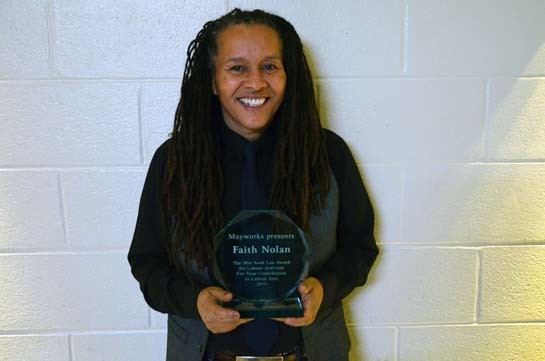
Nolan's album Fed Up, Overloaded and On the Line features songs she wrote collectively with social workers at the Catholic Children's Aid Society (CCAS), who were on strike at the time. It was released with CUPE in 2002.
"They had written two or three songs that they wanted to record," recalls Nolan. "I went to their workplaces and their picket lines and we would meet and talk about the issues that they had and create more music that way — through dialogue."
"They were overloaded," Nolan says of the social workers, referring to the album's title. "They had too many clients to deal with because of cutbacks to social services. Instead of having 25 people who needed services, they had 60, and they weren't able to take care of all of their clients. So, when they'd write the songs, they would cry. That kind of thing was really important to the social workers and they cried a lot. Their workload meant people were suffering. I think that's what really hurt them."
"Art," concludes Nolan, "is the best way to engage people."
MARGIE ADAM
Margie Adam moved to Toronto from Johannesburg, South Africa in 1975. She has worked as an art teacher, art educator, artist, and designer. Adam was blacklisted from teaching and instead continued on to run the Institute for Race Relations' Education Information Centre, in Johannesburg. Over a cup of coffee in her home in Toronto's Annex neighbourhood, she shared her experiences as an anti-apartheid activist and freelance designer.
"I was never told," she says of being blacklisted. "I guess that's one of the things about being blacklisted — you're never told." But it's pretty clear, to anyone who has experienced it.
"The education system, at the time, was Christian Nationalist, and it was very repressive," says Adam. "Obviously, I taught in a white school, but, even so, it was highly controlled. I don't want to say 'militarized,' but I guess there was an aspect of that.
"Anyway, I guess they just thought I was a subversive teacher and the only way I found out was because I left a job I was in, applied for other work, got the job and started my first day — and then I was told, no, in fact they 'didn't need me.' Then I'd go for another job and, on my first day or in an interview, I'd be told, no, they 'didn't need me.' Finally, one principal said, 'I don't know what you've done, but you've done something really bad, because I've been told I cannot hire you.' So I left teaching."
When Adam first arrived in Toronto, she started working at the Cross Cultural Communication Centre. While there, she did her first illustration and design work, on the book Making Changes: Employment Orientation for Immigrant Women, written by May Ann Kainola.
After that, she worked for the Toronto Committee for the Liberation of Southern Africa (TCLSAC) as an anti-apartheid activist. TCLSAC was actively engaged in supporting the struggles for liberation taking place in Angola, Mozambique, Namibia, South Africa and Zimbabwe.
After having her daughter, Adam returned to art, opened her own studio, and has been working as a freelance artist ever since.
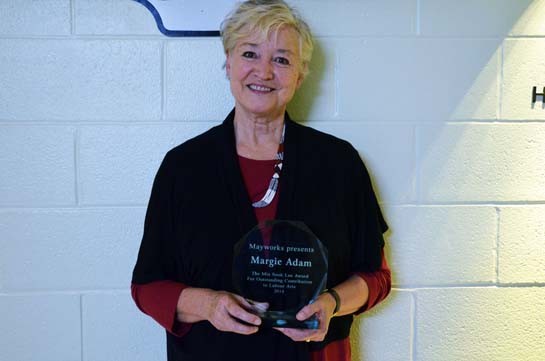
A lot of Adam's early work in Canada engaged with anti-racism, feminism, and international development in the context of Southern Africa. What brought her to labour organizations was the Steelworkers Humanity Fund. The union supported her work and made a point of communicating with and educating their membership around issues of international solidarity through games and workshops, many of which Adam helped create.
Education is at the core of Adam's work: the ability to use art to communicate information in a fun and accessible way. "I think it's absolutely integral," she says about education. "It's the purpose of the work — to raise consciousness."
One of her largest projects, which was showcased at the labour-arts awards gala, was a banner she made for Common Frontiers, a Toronto-based working group that began, in the 1970s, as a coalition against free trade. It now engages in research, educational campaigns and political action related to economic-, social- and climate-justice issues in our hemisphere.
"Margie did a lot of work for Common Frontiers over the years, including the illustrations for a popular education kit on trade and investment issues," says TCLSAC founding member Judith Marshall, who attended the awards gala and who has recently retired after 20 years working in the United Steelworkers' global affairs department.
"Common Frontiers asked Margie to design a banner for us to use as Canadian delegations to hemispheric events. She enlarged an image she had previously created of people participating in marches, and the banner became an ongoing project. It started with the first People's Summit in Santiago, Chile in 1998; then it went to Seattle and the WTO mobilization in 1999, and on through events in places like Quebec City, Caracas, Mar del Plata, and Trinidad over the next decade.
Common Frontiers went back to her regularly to add on yet more mobilizations, each one capturing, graphically, people in resistance. It depicted not only what we were against, but also the alternatives — the reality of the World Social Forum slogan, 'Another World is Possible.'
"I think we've had some really fine educators in the unions," Marshall concludes, describing examples of projects, publications and workshops that she's seen or contributed to that exemplify the creativity in the Canadian labour movement. Another example is the "My Public Library" campaign run by the Toronto Public Library Workers Union (CUPE Local 4948). This campaign received the labour arts award for "labour unions who have used the arts to engage their membership in different ways."
MAUREEN O'REILLY
Maureen O'Reilly has worked for the Toronto public library system for 28 years and has been active in the union for over 15 years. She was elected president of Local 4948 in 2010, the same year that previous Toronto mayor Rob Ford was elected. O'Reilly, an articulate speaker, is an encyclopedia of information about Local 4948's history, including the "My Public Library" campaign, which started five years ago.
"In 2009 we had a pretty successful round of collective bargaining," she recalls. "But we realized the environment was becoming more and more challenging. We realized we were going to have to do more. The first thing we wanted to do was showcase our members — the work they do and the challenges they face. Everybody loves libraries, but there's not an understanding, really, of a library as an organization. Everybody thinks everyone in a library is a librarian, but we actually have over 45 different classifications of workers."
The local set up a new website that included videos about their membership and the services that library workers provide. Then, in May 2011, the municipal Core Service Review was released. Contracted by the City of Toronto, auditing and consulting firm KPMG produced the report, which focused on services the city was providing and suggested where "efficiencies" could be found. For libraries, it meant closed branches and reduced hours. For communities, it meant a loss of access to libraries. For library workers, it meant a huge threat to their livelihood. In July that year, Local 4948 launched their campaign website, ourpubliclibrary.to, in an attempt to fend off the threat of service cuts.
"We're a service industry, and service is delivered by individuals," says O'Reilly. "If you're cutting the number of library workers who are delivering the service, you're cutting the service. That's something most politicians won't acknowledge."
One of the great successes of ourpubliclibrary.to, according to O'Reilly, was the use of software that would generate and maintain contact with a supporter database, based on who had signed the petition to support Toronto public libraries. This allowed Local 4948 to send updates to supporters as the municipal budget developed. These included letters that could be signed and sent to city hall. These letters, organized by postal code, would go to the mayor and to supporters' city councillors. This software gave Local 4948 a comprehensive understanding of their support base in the Greater Toronto Area , which would come in handy as their campaign evolved over the next three years.
That part of O'Reilly's term as president coincided with Rob Ford's time in municipal office has meant a very interesting presidency. The Ford administration unwittingly played a large part in raising the campaign's profile, through public comments by city councillor Doug Ford (advisor and brother of then mayor Rob Ford). Ford — and the campaign — gained the public's attention when he said there were more libraries than Tim Hortons outlets in his Etobicoke ward (which, of course, is untrue).
When world-renowned Canadian author Margaret Atwood tweeted back to him about the funding cuts, Ford's response to Atwood's tweeted criticism, and to her support of the pro-library petition, was: "I don't even know her. If she walked by me, I wouldn't have a clue who she is."
The media buzz around Ford's unprofessional comment (not a particularly novel experience for Torontonians during Rob Ford's tenure as mayor) only served to bring attention to the campaign.
The campaign culminated in a contest launched toward the end of that summer, called "My Library Matters to Me." Library fans were encouraged to submit personal essays in written, drawn or video format. The winners would get to meet with a number of famous Canadian authors including Atwood, who came up with the idea. "The submissions we received were unbelievable," says O'Reilly, "and very heartening for the library workers."
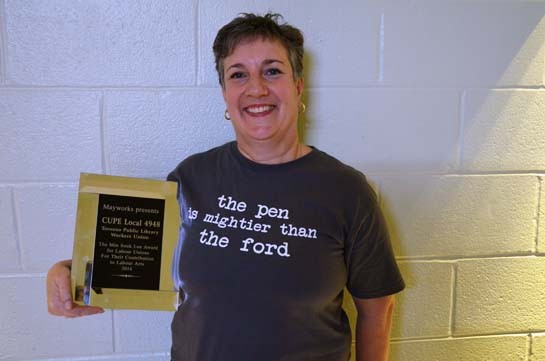
Library workers, says O'Reilly, are a very dedicated bunch of people. "Yes, it's a job. But most people work there because they really, really want to work there. It's almost a mission to them."
The acknowledgement of library workers as more than just service providers, but also as pillars of support in educational, intellectual and creative development, is essential. And the contest submissions, recalls O'Reilly, "were very good at getting at the heart of that. People almost always talked about the importance of connecting with a staff member — getting that connection in the city and in their community, and how it supported them, and transformed them."
By fall of that year, more letters were arriving at Toronto City Hall about library cuts than about transit issues or the cancellation of vehicle registration, which had been top campaign topics the previous year. In November 2012, the Canadian Centre for Policy Alternatives released a report called "The Great Equalizer," which showed that consistent cuts had been made for the preceding 20 years to Toronto libraries.
At that point, Local 4948 decided it was time to do more than prevent cuts and protect the library. It was time to refocus the conversation to celebrating libraries, and reinvesting in them. Working with award-winning Montreal-based illustrator James Braithwaite, they created the video Our Public Library. That effort is what Toronto's Mayworks festival recognized them for, at the Third Annual Min Sook Lee Labour Arts Awards. "The cartoon presented our issue in a fun and different way that, again, caught the imagination of so many people," says O'Reilly.
This segment of the campaign was launched in November 2013, following the use of a "librarian's glasses" prop at a photobooth that September at Word on the Street, the national annual book and magazine festival. The photos became a sort of "visual petition" according to O'Reilly. The glasses became a symbol of the campaign to support Toronto public libraries, and library workers, a fun use of the elderly female-librarian-with-glasses trope.
"It really caught people's attention," O'Reilly says of the video. "The illustrator did a really excellent job of capturing our issues in a very graphic and easily understandable way. Again making it lighthearted, the glasses were also used effectively in the cartoon."
"The focus of future campaigns will be reinvestment in the library service," says O'Reilly. "If Mr. Tory is honest in putting forward his statements that he wants to end divisiveness and make Toronto, 'Toronto the Good' again, the library service and its workers would be a huge unifying organization." (John Tory is now Toronto's mayor, elected last October.) "Supporting the library and its workers would be a great way to show that he is true to his commitments and his promises.
"Library workers are unique in that 86 per cent of them live in Toronto," says O'Reilly. "So, we are Torontonians, too, and, in order to be contributing members to the city, you have to have a stable, decent job. Goodness knows, I didn't become a library worker because I was gonna make a million dollars, but you expect to make a reasonable standard of living."
ALTHEA BALMES AND JO SIMALAYA ALCAMPO
Althea Balmes and Jo SiMalaya Alcampo were recognized by Mayworks as "artists who have captured the values of labour and social justice in their art," for their project Kwentong Bayan: Labour of Love. Balmes, Alcampo and the caregiver comic book were featured in Vol.33 No.3/4 of Our Times. Their project was introduced in the 2013 Mayworks Festival of Working People and the Arts, in collaboration with the Caregiver Connections Education and Support Organization (CCESO).
In 2014, Balmes and Alcampo co-produced the Mayworks event "Labour + LOVE: A Celebration of Caregivers." The event featured storytelling, spoken word, and musical performances. The goal was to bring conversations about the intersection of labour and migration to a wider audience.
The comic, which is set to come out later this year, is modelled after komiks, a popular form of political expression in the Philippines. But it engages with the very Canadian narrative of the Filipino diaspora in Toronto, Filipina caregivers in the Temporary Foreign Worker Program, and the relationships caregivers form here — and the ones they leave behind.
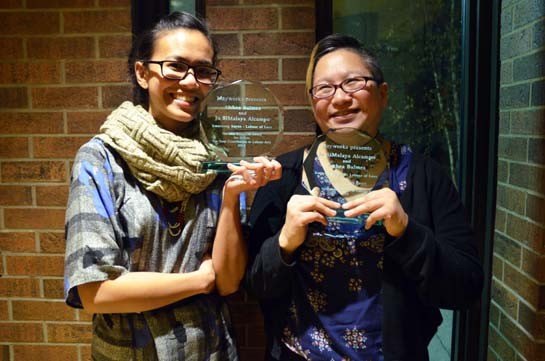
Both thoughtful and soft-spoken communicators, Balmes and Alcampo also inject a healthy dose of humour and laughter into their work and working relationship. "Comics are a good way to express and explore the complexity of our relationship with ourselves and with others, and how we interact with our environment all at the same time," says illustrator Balmes.
"Our project is based upon stories shared with us by caregivers, advocates and community allies," says writer Alcampo. "With any acknowledgement of our work, we are mindful of the migrant workers and caregivers who labour long hours with little recognition. We stand in solidarity with them. They make our work possible."
Indeed, for all these five award-winning women artists, it is workers who support, motivate and inspire them.
Haseena Manek is an Ottawa-based labour journalist, and Our Times’ Online Community and Outreach Coordinator. Follow her on Twitter here.


